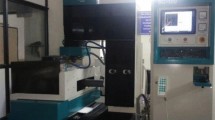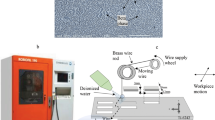Abstract
This paper investigates the finish cutting operation of wire electrical discharge machining for commercially pure titanium. The effects of key process parameters such as wire type (zinc coated and uncoated brass wire), pulse on time (T ON), pulse off time (T OFF), peak current (IP), wire feed (WF), servo voltage (SV) and wire offset (W OFF) were investigated, on machining characteristics (cutting speed, surface roughness) and the surface integrity after finish cut operation. It was confirmed from investigation that lower value of pulse energy parameters and W OFF, in conjunction with uncoated brass wire as a tool improves the surface finish in trim cut. The results of ANOVA elaborate that type of wire material, T ON and wire offset are very influential parameters for cutting speed and surface roughness during trim cut process. The scanning electron microscopy reveals that a smoother surface can be obtained while machining with lower T ON, IP and wire offset coupled with uncoated brass wire. Energy dispersive x-ray indicates higher concentration of oxygen content on trim cut machined surface rather than rough cut. The x-ray diffraction investigation reported that peak intensity gets lowered down due to increase of pulse discharge energy in trim cut stage of WEDM. Further, the fuzzy logic methodology is used to establish the optimal parametric combination for multiple responses characteristics using MATLAB7.8.0 (Release2009a) and MiniTab 15software.





























Similar content being viewed by others
References
Tosun N, Cogun C, Tosun G (2004) A study on kerf and material removal rate in wire electrical discharge machining based on Taguchi method. J Mater Process Technol 152:316–322
Moulton DB (1999) Wire EDM the fundamentals. EDM Network, Sugar Grove, IL. http://www.notebookmanuals.com
Ezugwu EO, Wang ZM (1997) Titanium alloys and their machinability—a review. J Mater Process Technol 68:262–274
Jangra KK (2012) Study of unmachined area in intricate machining after rough cut in WEDM. Int J Ind Eng Comput 3:887–892
Prohaszka J, Mamaalis AG, Vaxevanidis NM (1997) The effect of electrode material on machinability in wire electro-discharge machining. J Mater Process Technol 69:233–237
Lee SH, Xiaoping Li XP (2003) Study of the surface integrity of the machined workpiece in the EDM of tungsten carbide. J Mater Process Technol 139:315–321
Jawahir IS, Brinksmeier E, M’Saoubi R, Aspinwall DK, Outeiro JC, Meyer D, Umbrello D, Jaya AD (2011) Surface integrity in material removal processes: recent advances. CIRP Ann Manuf Technol 60:603–626
Hascalyk A, Caydas U (2004) Experimental study of wire electrical discharge machining of AISI D5 tool steel. J Mater Process Technol 148:362–367
Huang CA, Hsu FY, Yao SJ (2004) Microstructure analysis of the martensiteic stainless steel surface fine cut by the wire electrical discharge machining (WEDM). Mater Sci Eng A 371:119–126
Kumar A, Kumar V, Kumar J (2013) Parametric effect on wire breakage frequency and surface topography in WEDM of pure titanium. J Mech Eng Technol 1:51–56
Kumar A, Kumar V, Kumar J (2013) Metallographic analysis of pure titanium (grade-2) surface by wire electro discharge machining (WEDM). J Mach Manuf Autom 2:1–5
Kumar A, Kumar V, Kumar J (2013) Multiresponse optimization of process parameters based on response surface methodology for pure titanium using WEDM process. Int J Adv Manuf Technol 68:2645–2668
Kumar A, Kumar V, Kumar J (2013) Investigation of machining parameters and surface integrity of pure titanium after wire electric discharge machining. Proc Inst Mech Eng Part B J Eng Manuf. doi:10.1177/0954405413479791
Chalisgaonkar R, Kumar J (2013) Optimization of WEDM process of pure titanium with multiple performance characteristics using Taguchi’s DOE approach and utility concept. Front Mech Eng 8(2):201–214
Shabgard MR, Badamchizadeh MA, Ranjbary G, Amini K (2013) Fuzzy approach to select machining parameters in electrical discharge machining (EDM) and ultrasonic-assisted EDM processes. J Manuf Syst 32:32–39
El Hashmi K, Baradle MA, Ryan M (1998) Fuzzy logic based intelligent selection of machining parameters. Comput Ind Eng 35:571–574
Sengottuvel P, Satishkumar S, Dinakaran D (2013) Optimization of multiple characteristics of EDM parameters based on desirability approach and fuzzy modeling. Procedia Engineering 64:1069–1078
Lin JL, Lin CL (2005) The use of grey-fuzzy logic for the optimization of the manufacturing process. J Mater Process Technol 160:9–14
Sarkar S, Sekh M, Mitra S, Bhattacharyya B (2008) Modeling and optimization of wire electrical discharge machining of γ-TiAl in trim cutting operation. J Mater Process Technol 205:376–387
Huang Y, Ming W, Guo J, Zhang Z, Liu G, Li M, Zhang G (2013) Optimization of cutting conditions of YG15 on rough and finish cutting in WEDM based on statistical analyses. J Adv Manuf Technol, Int. doi:10.1007/s00170-013-5037-3
Kapoor J, Khamba J, Singh S (2011) Effects of cryogenic treated wire electrode on the surface of an EN-31 steel machined by WEDM. Int J Surf Eng Mater Technol 1:43–47
Antar MT, Soo SL, Aspinwall DK, Jones D, Perez R (2011) Productivity and workpiece surface integrity when WEDM aerospace alloys using coated wires. Procedia Engineering 19:3–8
Puri A, Bhattacharyya B (2005) Modeling and analysis of white layer depth in a wire-cut EDM process through response surface methodology. Int J Adv Manuf Technol 25:301–307
Huang JT, Liao YS, Hsue WJ (1999) Determination of finish-cutting operation number and machining-parameters setting in wire electrical discharge machining. J Mater Process Technol 87:69–81
Jangra KK (2014) An experimental study for multi-pass cutting operation in wire electrical discharge machining of WC-5.3% Co composite. Int J Adv Manuf Technol. doi:10.1007/s00170-014-6218-4
Kuriakose S, Shunmugam MS (2004) Characteristics of wire-electro discharge machined Ti6Al4 V surface. Mater Lett 58:2231–2237
Bhatnagar T, Srivatsan TS (2009) Processing and fabrication of advanced materials - XVII, vol 1. New Delhi, India
Zhecheva A, Malinov S, Long A (2005) Enhancing the microstructure and properties of titanium alloys through nitriding and other surface engineering methods. Surf Coat Technol 200:2192–2207
Kumar A, Kumar V, Kumar J (2012) Prediction of surface roughness in wire electric discharge machining (WEDM) process based on response surface methodology. Int J of Eng Technol 2:708–712
Kumar A, Kumar V, Kumar J (2013) Experimental Investigation on material transfer mechanism in WEDM of pure titanium (grade-2). Adv Mater Sci Eng. doi:10.1177/0954405413513013
Kumar A, Kumar V, Kumar J (2013) Surface integrity and material transfer investigation of pure titanium for rough cut surface after wire electro discharge machining. Proc Inst Mech Eng Part B J Eng Manuf. doi:10.1177/0954405413513013
Garg MP, Jain A, Bhushan G (2012) Modelling and multi-objective optimization of process parameters of wire electrical discharge machining using non-dominated sorting genetic algorithm-II. Proc Inst Mech Eng Part B J Eng Manuf 226:1986–2001
Liao YS, Yu YP (2004) Study of specific discharge energy in WEDM and its application. Int J Mach Tool Manuf 44:1373–1380
Poros D, Zaborski S (2009) Semi-empirical model of efficiency of wire electric discharge machining of hard-to machine materials. J Mater Process Technol 209:1247–1253
Kunieda M, Lauwers B, Rajurkar KP, Schumacher BM (2005) Advancing EDM through fundamental insight into the process. CIRP Ann Manuf Technol 54:64–87
Acknowledgment
The authors are highly thankful to AIRF JNU, New Delhi for providing SEM facility for surface integrity investigation.
Author information
Authors and Affiliations
Corresponding author
Additional information
Technical Editor: Alexandre Mendes Abrao.
Rights and permissions
About this article
Cite this article
Chalisgaonkar, R., Kumar, J. Investigation of the machining parameters and integrity of the work and wire surfaces after finish cut WEDM of commercially pure titanium. J Braz. Soc. Mech. Sci. Eng. 38, 883–911 (2016). https://doi.org/10.1007/s40430-015-0335-3
Received:
Accepted:
Published:
Issue Date:
DOI: https://doi.org/10.1007/s40430-015-0335-3




